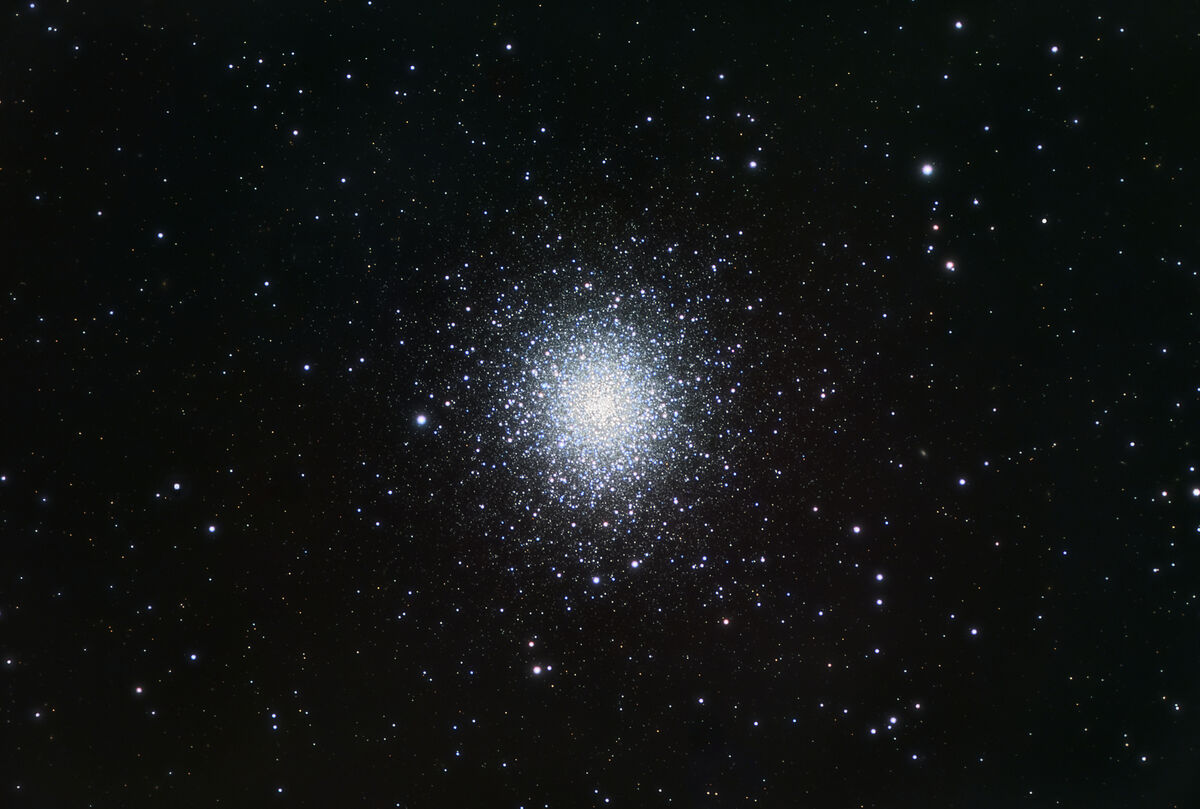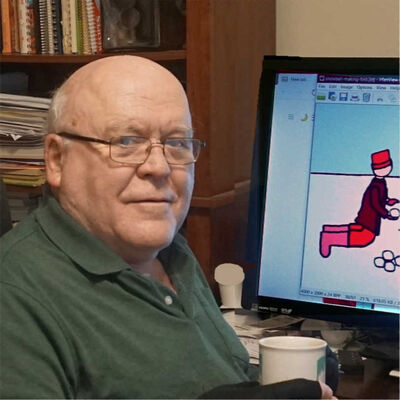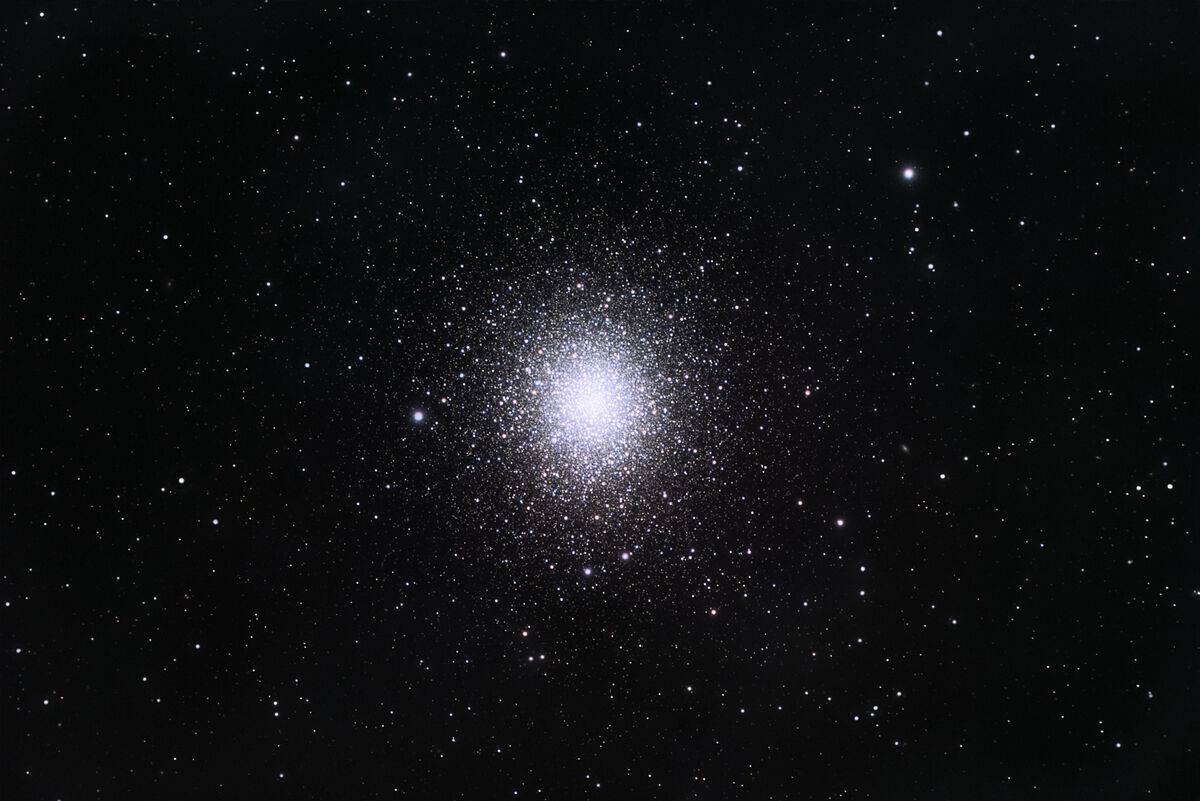M2 globular star cluster
Sep 21, 2023 15:26:58 #
Ballard
Loc: Grass Valley, California
In between the clouds and smoke I got some shots in of M2 the globular cluster in Aquarius. This cluster is ~55,000 light years away and 175 light years in diameter. It is estimated to be 12.5 billion years old and contains ~150,000 stars. There are a number of far off dim galaxies in the image, none of which appear in the charts that I have.
I had some issues with ASTAP as it had some trouble plate solving this object, so I had to go back and center it by hand before taken the shots and after the meridian flip. (I never had an issue with ASTAP before this point and it probably something to do with the long focal length and bright dense core of the cluster, I working with the folks at sourceForge.net to see I can get them the data needed to resolve the issue, I also need to update my version of SGPro just in case this caused the problem). I had to do be bit of extra noise reduction on the Blue image since clouds came in I didn't get as many blue shots in as I wanted.
All questions comments and suggestions are welcome.
For those interested I took the following exposures at a 4964mm focal length (F10) with an ASI 6200MM pro monochromatic camera set to -12C and the gain set to 100.
Luminance - 118 subframes taken for 1 minute each
Red - 36 subframes taken for 2 minute each
Green - 36 subframes taken for 2 minute each
Blue - 9 subframes taken for 2 minute each Clouds came in before I got all the blues
I had some issues with ASTAP as it had some trouble plate solving this object, so I had to go back and center it by hand before taken the shots and after the meridian flip. (I never had an issue with ASTAP before this point and it probably something to do with the long focal length and bright dense core of the cluster, I working with the folks at sourceForge.net to see I can get them the data needed to resolve the issue, I also need to update my version of SGPro just in case this caused the problem). I had to do be bit of extra noise reduction on the Blue image since clouds came in I didn't get as many blue shots in as I wanted.
All questions comments and suggestions are welcome.
For those interested I took the following exposures at a 4964mm focal length (F10) with an ASI 6200MM pro monochromatic camera set to -12C and the gain set to 100.
Luminance - 118 subframes taken for 1 minute each
Red - 36 subframes taken for 2 minute each
Green - 36 subframes taken for 2 minute each
Blue - 9 subframes taken for 2 minute each Clouds came in before I got all the blues
Sep 21, 2023 15:59:07 #
Beautiful!
I can't help but wonder if we are looking at the other side of a black hole.
Spewing stars from the other side.
I can't help but wonder if we are looking at the other side of a black hole.
Spewing stars from the other side.

Sep 21, 2023 17:20:53 #
Ballard
Loc: Grass Valley, California
SonnyE wrote:
Beautiful!
I can't help but wonder if we are looking at the other side of a black hole.
Spewing stars from the other side.
I can't help but wonder if we are looking at the other side of a black hole.
Spewing stars from the other side.

Hi SonnyE
Thanks for checking out the image of M2 and for the comment. They are wonderful objects to view, like looking at stardust.
Sep 21, 2023 20:57:36 #
Sep 21, 2023 22:46:43 #
Ballard
Loc: Grass Valley, California
nervous2 wrote:





Hi nervous2
Thanks for checking out the image of Messier object 2 and for the Thumbs up.
Sep 22, 2023 09:20:25 #
Ballard, looks like your collimation is spot on and the resolution of that big gun is excellent. Thanks for the time travel.
Sep 22, 2023 11:21:07 #
Ballard
Loc: Grass Valley, California
alberio wrote:
Ballard, looks like your collimation is spot on and the resolution of that big gun is excellent. Thanks for the time travel.
Hi alberio
Thanks for viewing the image of M2 and for the comment. I'm very happy with how well the meade stays in collimation and once I added Bob's knobs it is easy to collimate.
Sep 23, 2023 10:15:49 #
SonnyE wrote:
Beautiful!
I can't help but wonder if we are looking at the other side of a black hole.
Spewing stars from the other side.
I can't help but wonder if we are looking at the other side of a black hole.
Spewing stars from the other side.

That is a great photo. Thanks for getting it and sharing it.
Seeing this photo encouraged me to hunt for more info on M2. Wikipedia says it contains 150,000 stars in a rough sphere with a mass of 104,000 Mass of the Sun. Thus on the average, the stars in M2 have about 2/3 of the mass of the Sun. With the cluster having a radius of 87.3 light-years, the stars in the cluster average a distance of1.6 light years apart. This is not really close, but at 55,000 light years away from the Sun, they appear close together. --Richard
Sep 23, 2023 10:44:23 #
Ballard
Loc: Grass Valley, California
profbowman wrote:
That is a great photo. Thanks for getting it and s... (show quote)
Hi profbowman
Thanks for viewing the image of M2 and for the comment. With that many stars in fairly close to each other (at least compared to our neck of the woods) the night sky around a planet around one of those stars would have a very interesting view. However since Globular cluster are old >10billion years many of those stars formed when the metallicity of the universe was lower than when our system formed so rocky planets are probably fairly rare inside globular clusters.
Sep 23, 2023 23:52:00 #
Ballard
Loc: Grass Valley, California
Last night I finished taking some blue filter images of M2 and created a slight higher resolution and more color correct version of M2 (also known as NGC 7089). Total number of 2 minutes exposures for the image is now 34 in line with the other color filter images. This brought the total exposure time to 5 hours and 30 minutes.
After working with the folks at Source Forge I updated my plate solving star database to D80 and found that this one worked correctly for plate solving M2. Apparently the long focal length and high density of stars confused ASATP with the low resolution D50 database.
After working with the folks at Source Forge I updated my plate solving star database to D80 and found that this one worked correctly for plate solving M2. Apparently the long focal length and high density of stars confused ASATP with the low resolution D50 database.
Sep 24, 2023 08:53:10 #
Ballard wrote:
Last night I finished taking some blue filter imag... (show quote)
Excellent. --Richard
Sep 24, 2023 12:09:25 #
Ballard
Loc: Grass Valley, California
profbowman wrote:
Excellent. --Richard
Hi profbowman
Thanks for checking out the updated image of Messier object 2 also known as NGC 7089.
Sep 25, 2023 16:18:24 #
Ballard wrote:
Last night I finished taking some blue filter imag... (show quote)
They are both excellent.
But if I was to be a judge, I believe I would pick the first. To me, on my display, I like the first better.
That won't get you a cup of coffee. It just my opinion. LOL!
To me, it looks like stars spewing out of the back side of a black hole.
Sep 25, 2023 23:15:08 #
Ballard
Loc: Grass Valley, California
SonnyE wrote:
They are both excellent.
But if I was to be a judge, I believe I would pick the first. To me, on my display, I like the first better.
That won't get you a cup of coffee. It just my opinion. LOL!
To me, it looks like stars spewing out of the back side of a black hole.
But if I was to be a judge, I believe I would pick the first. To me, on my display, I like the first better.
That won't get you a cup of coffee. It just my opinion. LOL!
To me, it looks like stars spewing out of the back side of a black hole.
Hi SonnyE
Thanks for viewing both images of M2 and for the comment. The bluer image in the first attempt has a very pleasing look to it. However the color in the second is probably closer to reality as the majority of the stars in a global cluster tend more towards the red and yellow due to their age. I also was able to reduce the noise more in the second image resulting in slightly sharper stars. I was also able to stretch the second image more revealing more of the distant background galaxies.
Sep 28, 2023 14:52:46 #
If you want to reply, then register here. Registration is free and your account is created instantly, so you can post right away.




